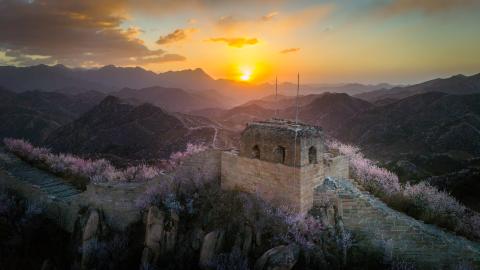From the U.S., Libya may seem like a homogenous place, the setting for a distant war. But Libya's scant six million people are surprisingly culturally diverse, and Libya's indigenous inhabitants, Berbers known in Libya as Amazigh, are part of an ethnic group that spans parts of Algeria, Morocco, Egypt, Chad, Mali, and Burkina Faso. They have a written language whose oldest inscriptions date from 200 B.C.—but it fell victim to Muammar Gaddafi's idiosyncratic Arab nationalism and was harshly suppressed to the point where most Amazigh adults cannot read or write it.
Today, as Libyans awaken from their 42-year-long bad dream, the country's estimated 165,000 Berbers are proudly reclaiming their culture. Berber revolutionaries painted the "Z" symbol of their people on their pickup trucks, and wore T-shirts with the Amazigh flag on one side, the Libyan on the other. And the Amazigh women of Jadu in the Nafusa Mountains—free since the end of February—are flexing their muscles in their own way.
The moment you step inside the headquarters of the Sun of Freedom women's association of Jadu and see the sketch of the Amazigh flag on the wall, it's apparent that this charitable organization is as much about reviving traditional Berber culture as it is about aiding the roughly 5,000 internally displaced people, many Amazigh, who have fled from Tripoli, Zwara, and other coastal cities to take refuge here.
The Amazigh people have long struggled against Gaddafi, and during the fighting against him—now in its sixth month—as many as 150,000 people have been displaced. For the Amazigh, the struggle is not just a struggle to unseat a despot; it's a struggle to reclaim their ancient language and traditions.
In Jadu, a town of about 10,000 Amazigh set on a mesa high above the plain that runs north to Libya's west coast, a group of women, mainly teachers, have been preparing meals for the internally displaced people, and teaching Amazigh children. With Ramadan turning schedules nocturnal, the women are preparing daily breakfast meals, called iftar.
Before the Feb. 17 revolution here, women weren't allowed to be active outside the home, says Amal Kahber, one of the 15 or so women active in the Sun of Freedom organization. Thought they were permitted to be school teachers, they did not spend time in public or interact with strangers. But now, she says, times are changing. In addition to cooking for the refugees, the women have tutored children in Arabic, English, and Amazigh. Schools here, as elsewhere in "free Libya," closed in late February and have yet to reopen, although there are plans for some to do so next month, according to the Transitional National Council Education Minister Suliman el Sahli. The women also ran a charity fashion show featuring young girls in traditional Amazigh dress.
But beyond more conventional charitable works, the Sun of Freedom organization is devoted to the Amazigh culture, long ignored by Libyan Arabs and actively suppressed by Gaddafi. Until Jadu freed itself of Gaddafi's control in February, even speaking Amazigh in public was forbidden. The language wasn't taught in schools, and today, only the older generation and a few younger people know how to write the 32-character, 2,200-year-old phonetic language. "I'm the only one in my family who can write Amazigh," says 16-year-old Amani Giadwi, a Tripoli banker's daughter, in perfect English.
Amani and her sister Nada interrupt each other excitedly as they explain the history of their culture. They assert that the Amazigh are the original inhabitants of Libya, and gave the country its name. "Gaddafi said that all Amazigh are Arabs—but we are not!" Amani exclaims vehemently. The Berber culture encompasses many of the indigenous people in North Africa including those in Algeria, Morocco, Libya, and Tunisia, although their dialects vary.
Despite their devotion to the Amazigh cause, the women's knowledge of Berber culture is fragmentary and local, just as Gaddafi wanted. They have never heard of the magnificent rock carvings at Slonta, Berber art near al Bayda on the east coast that predates the Greek colonization. In turn, the urban population on Libya's east coast has little knowledge of the Amazigh—several Arab freedom fighters told me they had known nothing of the Nafusa Mountains until their brigades from other parts of Libya came to fight and train here.
Amazighs look like other Libyans, but the feel of their culture is more free and open. Compared to the Arab town of Zintan just 15 or so miles away, Jadu seems more liberal. Women walk in small groups to the "supermarket" downtown here, and are dressed less conservatively than in Zintan. And the Giadwi sisters drive around without a male escort—something that would make news in Zintan.
What the future holds for these Berber women will depend on the outcome of the still-intense fighting going on for control of Libya.
Still, this is no feminist paradise. An iftar I attended last week at a Jadu mosque was otherwise attended only by men, and women are never seen out at Jadu's only coffee shop. Within the Nafusa Mountains, culture differs from town-to-town and among the Berber towns as well. I was able to verify for myself the claim of Senussi Mahrez of Zwara, who commanded 200 fighters at a camp in Jadu, that Zwara is more liberal than Jadu. He also called the Berber town of Nalut, which I did not visit, "the Amazigh Zintan," for its conservatism.
What the future holds for these Berber women will depend on the outcome of the still-intense fighting going on for control of Libya. But it seems likely that their ancient culture and its fascinating language will enjoy an unexpected revival. Encouragingly, on the night of the Tripoli uprising that sent Libyans into the streets in joyous sympathy all over free Libya, the women of Jadu came out spontaneously and for the first time in history celebrated in public with the men.















